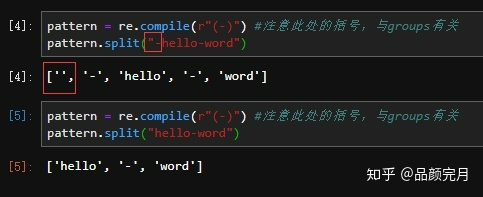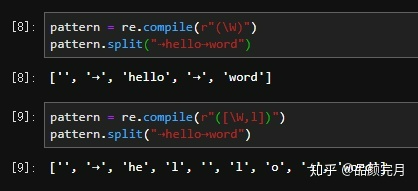https://zhuanlan.zhihu.com/p/114371624
正则表达式-python:split的用法
在python种split的作用:修改字符串(Modifying a string)
In almost every language, you can find the split operation in strings.
在python3中使用split特别注意两点:
- 正则表达式(pattern)带不带括号的区别
第一个字符就与正则表达式匹配,结果中的第一个位置会包含一个空字符(Note that when a group matches the start of the string, the result will contain the empty string as a first result.)
正则表达式(pattern)带不带括号的区别
第一个字符就与正则表达式匹配
参数maxsplit的用法:
需要多个分隔符时用中括号[]
Modifying a string
In almost every language, you can find the split operation in strings.
import re
- Note that when a group matches the start of the string, the result will contain the empty string as a first result:
re.split(r”\n”, “Beautiful is better than ugly.\nExplicit is better than implicit.”) [‘Beautiful is better than ugly.’, ‘Explicit is better than implicit.’] re.split(r”(\n)”, “Beautiful is better than ugly.\nExplicit is better than implicit.”) [‘Beautiful is better than ugly.’, ‘\n’, ‘Explicit is better than implicit.’] pattern = re.compile(r”(-)”) #注意此处的括号,与groups有关 pattern.split(“-hello-word”) [‘’, ‘-‘, ‘hello’, ‘-‘, ‘word’] pattern = re.compile(r”(-)”) #注意此处的括号,与groups有关 pattern.split(“hello-word”) [‘hello’, ‘-‘, ‘word’] pattern = re.compile(r”\W”) pattern.split(“Beautiful is better than ugly”, 2) #The maxsplit parameter specifies how many splits can be done at maximum [‘Beautiful’, ‘is’, ‘better than ugly’] pattern = re.compile(r”\W”) pattern.split(“Beautiful is better than ugly”) #The maxsplit parameter specifies how many splits can be done at maximum [‘Beautiful’, ‘is’, ‘better’, ‘than’, ‘ugly’] pattern = re.compile(r”(\W)”) pattern.split(“⇢hello⇢word”) [‘’, ‘⇢’, ‘hello’, ‘⇢’, ‘word’] pattern = re.compile(r”([\W,l])”) pattern.split(“⇢hello⇢word”) [‘’, ‘⇢’, ‘he’, ‘l’, ‘’, ‘l’, ‘o’, ‘⇢’, ‘word’]
发布于 2020-03-19 14:28





